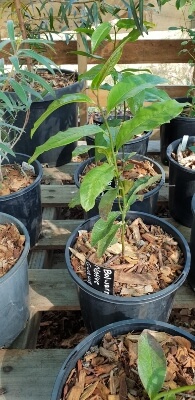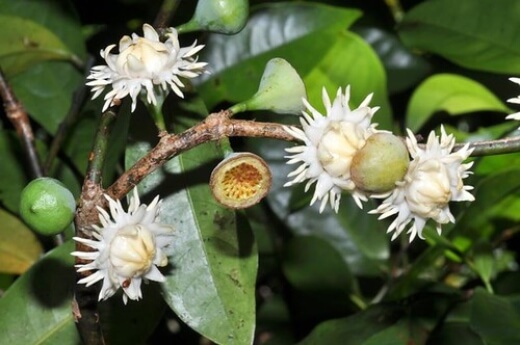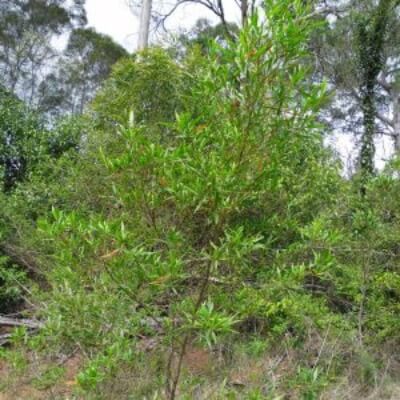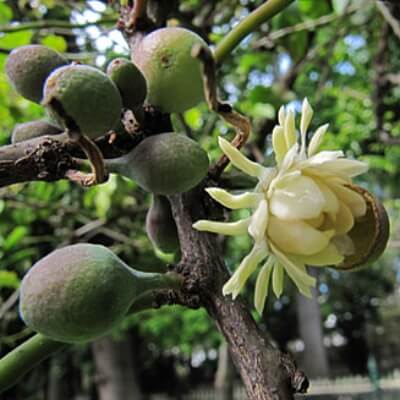Bolwarra or the native guava is a fascinating fruit that has been appreciated and enjoyed by Australians going back to the 19th century. Packed with flavour and goodness, it certainly has plenty to offer.
Our guide will focus on a bit more about the Bolwarra, before we get into how to propagate your own at home. Care for this shrub or tree is rather simple as you will see, and it has a rich history and varied use in terms of bush tucker.
More...
Family: | Eupomatiaceae |
|---|---|
Genus: | Eupomatia |
Species: | E. laurina |
Origin: | Australian Native |
Common Names: | Bolwarra, Native guava |
Location: | Outdoor or indoor |
Type: | Small tree or large shrub |
Growth: | Up to 5 metres tall and 4 metres wide |
Sun requirements: | Shade |
Foliage Colour: | Dark green |
Flower Colour: | Cream |
Flowering: | Spring, summer |
Fruit: | Green/yellow exterior and interior that resembles guava, tart flavour |
Maintenance level: | Average |
Poisonous for pets: | No |
Introducing Bolwarra
Bolwarra is the name given to the native guava by the Aborigines but you might also have heard it referred to as Copper Laurel or even Scented Laurel. This much loved native shrub occurs naturally in eastern Australia, producing fragrant flowers and delicious fruit.
Eupomatia laurina usually grows as a large shrub but in natural rainforest it can grow to the size of a small tree. It has bright green leaves but sometimes the new leaves can be an orange or red shade.
Eupomatia laurina Plant Features
The flowers produced by the native guava are white and make their appearance in spring. They don’t last for very long unfortunately, sometimes just for a day. The flowers have a lovely lemon scent.
The Bolwarra fruit that follows after the flowers is a type of green capsule that shows up in summer. You can eat this fruit when it’s ripened. The fruit is very much like guava, sweet and creamy with lots of seeds.
Native guava fruit is often dried and crushed to be used as a spice, and is popular in local cooking for everything from drinks to desserts. Bolwarra berries become ripe during winter. They change from green to brown and they will be soft. You can eat them straight off the plant if you like.
How to Grow Bolwarra Plant
Eupomatia laurina enjoys shade. It will do well with extra watering during dry seasons and mulching will help contain the much needed moisture. The native guava, as a rainforest plant, needs to be protected from frost and also from hot and dry wind. It can be grown in a pot or in the garden.

Propagating Bolwarra
It is possible to propagate Bolwarra using different techniques. These include using seeds or cuttings, but can also be achieved through grafting and layering.
Growing from seed is probably the easiest way to propagate your own native guava and is the method used most often. You are able to collect the seed from an existing Bolwarra fruit and plant it directly in soil without any pre-treatment.
It does require patience as the seeds might take a few months to germinate. Plant them in a well-draining potting mix and keep it moist but never soggy.
If you are propagating from cuttings, these can be taken from semi-hardwood shoots at the end of summer and planted in a well-draining mix as you would with seed.


Get Your Free Guide:
Master Growing Australian Natives eBook
A Must Have Complete Guide for Every Australian Garden
Get Your Free Guide:
Master Growing Australian Natives eBook
A Must Have Complete Guide for Every Australian Garden
How to Care for a Bolwarra Plant
Climate
Eupomatia laurina is a rainforest plant which means tropical and subtropical climate is what it knows naturally. It will grow well though in any area that doesn’t have frost.
Sunlight
Bolwarra prefers to grow in shade and somewhere protected. If it gets lots of sunlight it will start to wilt and won’t grow well. If it doesn’t get enough moisture it will also fail to thrive.
Native guava will even grow in very strong shade so underneath trees with very little light coming through will be ideal. You could also opt to grow it indoors.
Soil
Native guava grows well in most soils whether sandy, clay or loam or a combination of these. In terms of pH, Bolwarra can do mildly acidic or alkaline but neutral is also good. We recommend adding mulch to help maintain soil moisture and keep weeds under control.
Watering
Bolwarra needs moderate watering and prefers moist soil. During dry weather, be sure to give it extra water.
Pruning
You can do pruning of your Bolwarra plant during spring and this helps to promote even more growth. You’ll notice that the shrub creates some new stems now and then but you can prune these off if you want to keep the plant to just one stem.
Fertiliser
We recommend using a slow release fertiliser during spring.
Bolwarra Bush Tucker Guide
Bolwarra is often known as native guava because it looks very similar to the guava we know on the inside. The outside of the fruit is green and once they become ripe, they turn yellow and have a fleshy type of jelly on the inside. It also has plenty of seeds like guava.
The Bolwarra fruit is found naturally in the rainforests in New South Wales. The flavour of the fruit can best be described as tart as it has both a sweet and sour taste. It’s a much loved ingredient to add to desserts and other sweet treats but is just as delicious in soup and curry with a delightful crunchy texture.

Source: Leaf Whispering in the Tropics
Native Guava Health Benefits
Eupomatia laurina is packed with health benefits. It’s high in antioxidants, and works well as an anti-inflammatory and to improve digestion. The fruit has plenty of vitamin A, B, C, and dietary fibre, along with calcium, magnesium and potassium.
The vitamin A keeps eyes and skin healthy and promotes cell regeneration. The high levels of vitamin C found in Bolwarra promote a strong immune system and help wounds to heal quicker. It can also reduce your risk of heart disease and cancer.
Dietary fibre is a great helper to keep cholesterol low and keep diabetes risk down as it helps to regulate blood sugar levels.
More About Bolwarra Plant
Historically, Bolwarra has been known as the Bush Banana or Kurrajong, providing a vital food source for the Aboriginal people. The use of the Bolwarra fruit goes back to the beginning of the 19th century and by the start of the 20th century, the native guava was a popular source of food for Australians.
The Australian government named Bolwarra a protected species in 1921 which meant it could be cultivated and sold, as well as exported. Bolwarra has become popular in other countries who have discovered its flavour and also the nutritional benefits.
For more bush tuckers easily found in New South Wales, check out our growing guides below:
Eupomatia laurina Pests and Diseases
Myrtle rust is a type of fungal disease. It affects the Bolwarra by causing misshapen leaves and lots of leaf loss, as well as stunted growth and dieback that affects the leaves, fruit and flowers. If left untreated, it will eventually kill the plant.
Usually the first thing you would notice is little pustules on any new growth on the plant. Within a few days these pustules pop and release their yellow spores. Over time, the infection spreads and these pustules all link together.
If possible, first spray both the infected and normal plants with a fungicide about four days before you plan to remove them. If you opt not to or can’t treat with fungicide, you can gently wet the plants to make the spores damp before the Bolwarra is removed. In the case of a small plant, you can actually apply some hairspray to keep the spores in place.
When it comes to removing the Bolwarra, if still small, you can pop a plastic bag over it and then pull it out. In the case of a native guava grown in a pot, you’ll need to get rid of the entire plant and the pot, put it in a bag and seal it well.
If your Bolwarra is already quite large, you can cut it up into small pieces, cover these with black plastic bags, and then leave in a place with lots of sunlight for about 4 weeks to kill off the spores. This is essential if you didn’t use any fungicide for treatment beforehand.
Frequently Asked Questions About Bolwarra Plant

Source: Paten Park Native Nursery
How long does it take for the native guava to bear fruit?
Bolwarra that has been propagated from cuttings will bear fruit after two years, whereas the use of seeds for propagation means the plant will take between 4 and 6 years for fruit to appear.
How many species are included in the Eupomatia genus?
This genus includes just 3 species of shrubs which are found naturally in rainforest and eucalypt forests in eastern Australia and New Guinea.
What kind of wildlife is attracted to Bolwarra?
The fruit of the Eupomatia laurina is loved by birds including Australian king parrots but also provides food for the Common Redeye butterfly and the weevils responsible for pollination of its flowers.
The great thing about these weevil pollinators is that they are not a threat to other plants in your garden. The small brown weevils are attracted to the flowers thanks to their delightful fragrance.
Where does the Eupomatia laurina get its name?
This plant is known by a few different names. Native guava is relative to the look and taste of the fruit, and another name is Copper Laurel, given due to the leaf shape and because the leaf colour becomes a copper shade in winter. Bolwarra is the Aboriginal name given.
Eupomatia is from Greek and ‘eu’ means good, while ‘pomatos’ or ‘poma’ refers to the type of covering that the flowers have. Laurina is derived from the Latin word ‘laurus’ which makes reference to the look of a laurel.
Why are the leaf edges of my Bolwarra turning brown?
Your plant watering schedule is usually the reason for the tips of the leaves becoming brown. If your watering has been inconsistent and the Bolwarra is drying out too much between watering sessions, this could be the reason.
What are the other species in the Eupomatia genus?
Eupomatia bennettii or small Bolwarra, and Eupomatia barbata, also known as the northern Bolwarra and is very rare.
Keen to read more about Australian bush tucker and get more garden inspiration? Sign up for our newsletter.
Wrapping Up Our Bolwarra Growing Guide
When I think about the things that make me proud to be an Australian, the richness of our natural beauty and plant life is without a doubt at the top of my list. I am just in awe of how much goodness can be contained in a bolwarra fruit, and how nature has been providing for our wellbeing for centuries.
Published on May 30, 2023 by Lorri Hopkins
Last Updated on January 19, 2025






Hello Lorri,
We have a Bolwarra plant and it sits under the shade of a Mulberry tree that thrives.
We have noticed that some of the leaves have been wilting and turning brown. We removed the dead parts but cant understand what the problem could be. There has been a lot of rain recently. What do you recommend we do?
Thank you
Hi Fionnuala,
I’m sorry we missed this comment coming through, and I hope it isn’t too late!
How long has it been planted there? Dried brown leaves are pretty common, but wilting brown leaves on copper laurel is pretty unusual, especially in those sort of shady conditions.
If it isn’t fully established it might be that it’s being outcompeted for moisture by the Mulberry, and could therefore be moved to another location (the fact you’ve cut it back significantly might make that easier too).
Another possibility is stem borers, which could have caused an internal infection in one of the main branches. If you’ve cut back to beyond the point of damage/wilting, the tree should recover, as long as you rake up any fallen leaves that could harbour the infection.
And sorry again that I missed this message. I hope we can help.
Good luck,
Lorri Hopkins